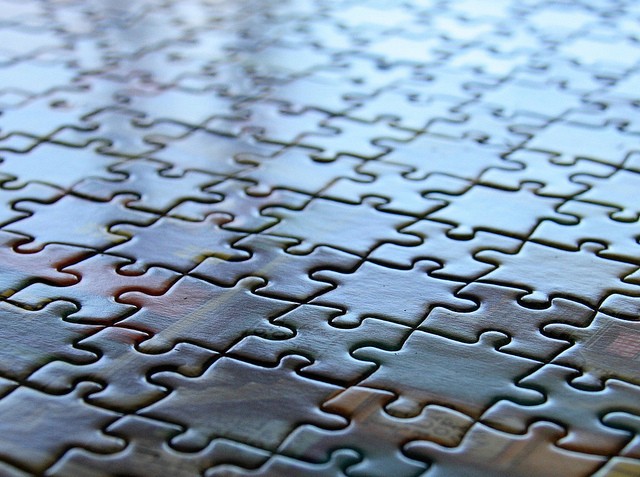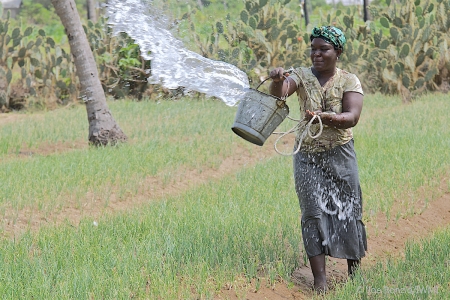In a recently released review of the Sustainable Development Goals (SDGs), my colleagues and I find that the goal on food security, improved nutrition and sustainable agriculture is a vast improvement over the Millennium Development Goals, which did not consider agriculture at all. But, the SDGs fail to address important complementarities and tradeoffs among goals and their targets.
 Photo: Kyknoord on Flickr
Photo: Kyknoord on FlickrMy colleagues and I were part of a group of 41 scientists who were asked to implement a scientific review of the SDGs and targets to guide policymakers in the finalization of the SDGs.
We focused on the second goal (of the 17 total): food security, improved nutrition and sustainable agriculture. Sustainable agriculture is key to ending hunger, but inequality and ensuring universal access to safe drinking water and sanitation are also important; these interlinkages are unaddressed by the 17 separate SDGs.
Several goals will remain out of reach of the poorest.
Care must be taken to simultaneously defeat hunger, increase agricultural productivity and avoid adverse impacts on the natural resource base. If we do not address key interlinkages among goals and targets, and reduce tradeoffs, several goals will remain out of reach of the poorest.
For example, an increase in agricultural land to help end hunger can lead to biodiversity loss, as well as overuse and/or pollution of water resources and downstream (likely negative) effects on marine resources, which in turn could exacerbate food security concerns.
If there are so many interconnections, what can be done?
Tradeoff analysis is one solution. Governments in developing countries will move ahead in addressing at least some of the SDGs either way but they can go a lot further if they assess the tradeoffs and synergies across goals and targets supporting the goals.
The selection of indicators for the targets and SDG is another avenue to ensure that tradeoffs and synergies among goals and targets are accounted for. For food security and nutrition indicators are already well-established, but protocols and data collection are insufficient to measure changes in hunger (e.g. calorie availability per capita per day, dietary diversity score, stunting/wasting with a focus on those below the age of 5 and a specific focus on those below the age of 2, as well as the measuring of micronutrient deficiency indicators keyed to the regions where specific deficiencies are most prevalent).
Indicators for sustainable agriculture, however, are much more complex as important tradeoffs even exist among some of the indicators supporting sustainability in agriculture, such as emissions per hectare of agriculture land; crop and animal yields per unit of water; energy intensity of agriculture, etc.
The SDGs take a significant step forward into the complexity of sustainable human development. This complexity requires support from the scientific community, including targeted capacity building for tradeoff analysis and monitoring.
How can we move forward?
We, the scientific community, including CGIAR, are ready to work with the Open Working Group and the UN Statistical Commission to identify key tradeoffs and interlinkages and to identify appropriate indicators to monitor the implementation of the SDG targets.
The report mentioned above was released on February 12th and presented to the to United National delegations soon after during a major negotiation session of the Open Working Group that is finalizing the SDGs. The SDGs are slated to be approved at the General Assembly of the United Nations in September.






/index.jpg?itok=EzuBHOXY&c=feafd7f5ab7d60c363652d23929d0aee)








Comments
I had already downloaded but have not yet read the full report. Based on this blog I wonder if the author being diplomatic has reduced the impact of the observations in the main report? I think that there are more serious problems with the current OWG version of the SDGs than comes across in this blog. My reading is they fail utterly to address nexus issues and the challenges posed by the trends described in the literature on the "Anthropocene". And with regard to water specifically, they fail to address the problem of broader access to water for productive purposes, and over-emphasize increasing water use efficiency and conservation at the expense of equal access. A more rigorous debate is needed urgently.
Dear Doug,
the short blog only mentions a few of the issues related to SDG2 and not to SDG6. It appears that the goals and targets do fall well short of what many had hoped, but there seem to be so many shareholders in this process that no one can be really happy with the outcome. It was clear for SDG2 as well that a series of strong constituents had added lots of unnecessary material while key issues, such as a focus on the first 1000 days for nutrition or the mixing of targets that focus on sustainability with those that do not slipped through. There is still hope for the indicators but it seems that the train for goals and targets has left the station. I also believe that tradeoff analysis will be useful to show some of the contradictions across goals and targets. Regards, Claudia
History seems to repeat itself and it would be hard to imagine that anything will change in the next 15 years (until 2030). It doesn't really matters because at the end, the indicators used are somewhat meaningless and contradictory.
After more than 25 years of development we still measure success to address poverty with the $1.25 a day. Would you call that success?
Nutrition has little to do with agriculture alone. It has to do with infrastructures, with education, with health, with transport -- but this is not how we measure success.
Public policies are often the worst enemy to development. Look at the European focus on bio-fuels? Good productive land is being used to massively cultivate sugar cane in Cali (Colombia) instead of food.
Food is big business and on international markets it's mostly referred to as "commodity" - so who is the victims? We, our self, make it unsustainable! Our pension funds, our investment drive up the prices or drive down the prices in order to play the speculation game.
What are the odds that in the next fifteen years this situation will change? Slim to none is the answer. Funding for development focuses on a particular indicator -- AIDS never really speaks about Tuberculosis. Education never speaks about nutrition, and so on!
Are we talking about the UNsustainable development goals?
Hypercollectively yours -- Luc Lapointe